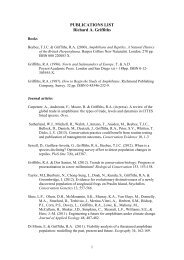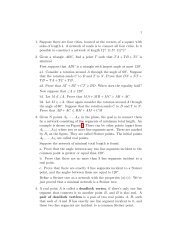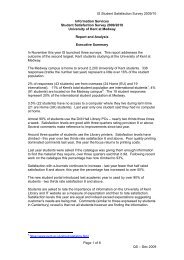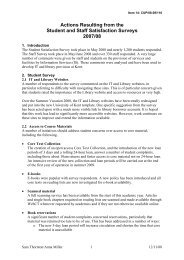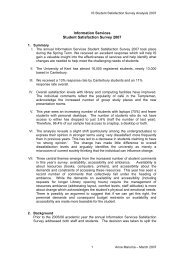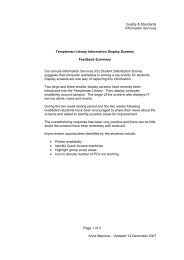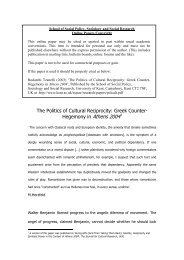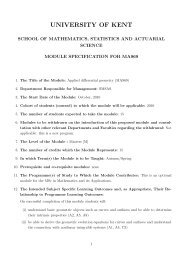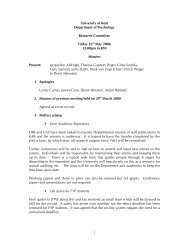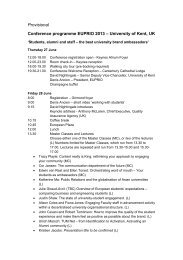The Million Pound Donors Report 2012 - University of Kent
The Million Pound Donors Report 2012 - University of Kent
The Million Pound Donors Report 2012 - University of Kent
Create successful ePaper yourself
Turn your PDF publications into a flip-book with our unique Google optimized e-Paper software.
| 03 |<br />
DISCUSSIOn<br />
<strong>The</strong> findings presented on the previous pages raise some<br />
interesting and important issues. This section discusses<br />
the following four themes and questions:<br />
1. <strong>The</strong> importance <strong>of</strong> an expanded pool <strong>of</strong><br />
million pound donors<br />
2. <strong>The</strong> continuing importance <strong>of</strong> and changing<br />
context for philanthropy<br />
the MIllIon PoUnd donors rePort <strong>2012</strong><br />
3. What is philanthropy for in contemporary<br />
society?<br />
4. Encouraging more philanthropy<br />
While this report focuses on the UK, to contextualise the<br />
contribution <strong>of</strong> million pound donors it is also worth<br />
considering broader trends in philanthropic and charitable<br />
giving in 2010/11.<br />
Broader trends in philanthropic and charitable giving in 2010/11<br />
<strong>The</strong> UK Giving report, produced by the national Council for Voluntary Organisations (nCVO) and the Charities<br />
Aid Foundation (CAF), surveys the giving <strong>of</strong> ‘ordinary’ donors, who give on average around £30 a month. This study<br />
found that general charitable giving did not increase between 2009/10 and 2010/11, totalling £11 billion in real<br />
terms in each <strong>of</strong> these years. This remains lower than the peak total <strong>of</strong> £11.3 billion identified in 2007/08, which is<br />
the period just before the onset <strong>of</strong> the recent recession that is still causing such widespread difficulties.<br />
<strong>The</strong> findings in the Sunday Times Rich List 2011 are consistent with those presented in this report, showing both a<br />
decrease in the total value <strong>of</strong> charitable donations at the same time as showing an increase in the number <strong>of</strong> the<br />
wealthiest individuals and families who are giving away substantial sums.<br />
Citing the impact <strong>of</strong> the financial crisis as the reason for the £818 million drop in donations from the top 100<br />
philanthropists identified in their list, the Sunday Times also writes <strong>of</strong>, “a growing recognition <strong>of</strong> the importance <strong>of</strong><br />
philanthropy in these difficult times”, noting also that, “the top 30 philanthropists in the [Sunday Times Rich] list<br />
gave away a bigger proportion <strong>of</strong> their wealth, donating at least 3.42% compared to 3.22% in the previous year.”<br />
Looking internationally, findings from the <strong>Million</strong> Dollar List collated by the Center on Philanthropy at Indiana<br />
<strong>University</strong> also show consistencies with our data. For example, more gifts are given at the lower end <strong>of</strong> what is<br />
possible ($5 million or below) than the ‘mega-gifts’ <strong>of</strong> up to 11-figures, such as the donations totalling c$30 billion<br />
from each <strong>of</strong> Bill Gates and Warren Buffet that captured so much media attention.<br />
In the US, as in the UK, individuals account for the biggest proportion <strong>of</strong> gifts worth $1 million or more as their<br />
average gift size tends to be much higher than donations made by institutional donors (charitable trusts and<br />
foundations and corporations). <strong>The</strong> distribution <strong>of</strong> million dollar donations is also in line with million pound<br />
donations, with around half the money being ‘banked’ into foundations for distribution at a later date, and Higher<br />
Education being the most popular destination for donations that are ‘spent’ directly on charitable activity.<br />
Finally, in terms <strong>of</strong> the number <strong>of</strong> donors and value <strong>of</strong> donations, the US data also follows a similar pattern to the UK,<br />
showing an increase in the number <strong>of</strong> individual donors from 2009 to 2010 (from 455 to 605) yet a decrease in the<br />
value <strong>of</strong> their donations (from $4.97 billion to $4.44 billion).<br />
Commenting on our findings, Una Osili who is director <strong>of</strong> research <strong>of</strong> the Center on Philanthropy at Indiana<br />
<strong>University</strong>, says:<br />
“In the US, on average, million dollar-plus gifts by individuals tend to be for significantly larger dollar amounts than<br />
gifts by foundations and corporations. US individuals also give mega-gifts <strong>of</strong> $50 million or more at disproportionately<br />
higher levels than the other donor types.<br />
As in the UK, the most common subsector for million dollar gifts is Higher Education, but in contrast to the UK, Health<br />
and Public and Society Benefit Organisations are the next most popular subsectors. This contrasting focus is particularly<br />
interesting given the rising visibility <strong>of</strong> the philanthropic sector, globally.”<br />
15



